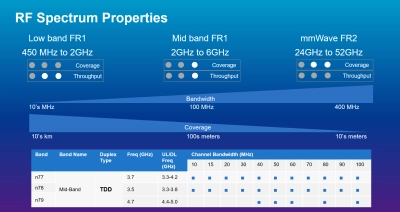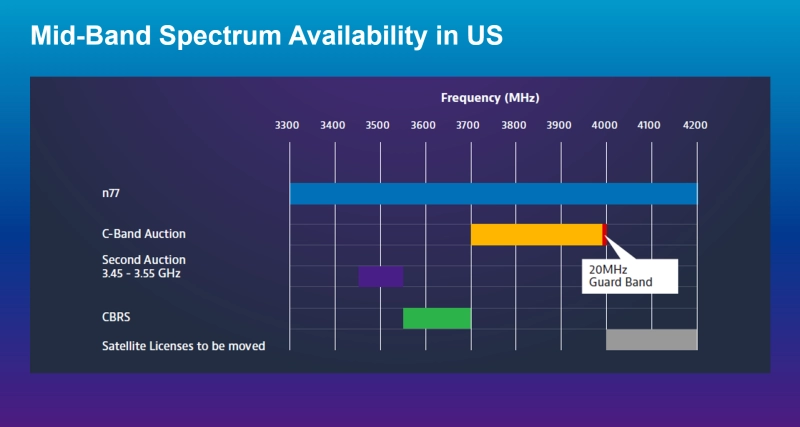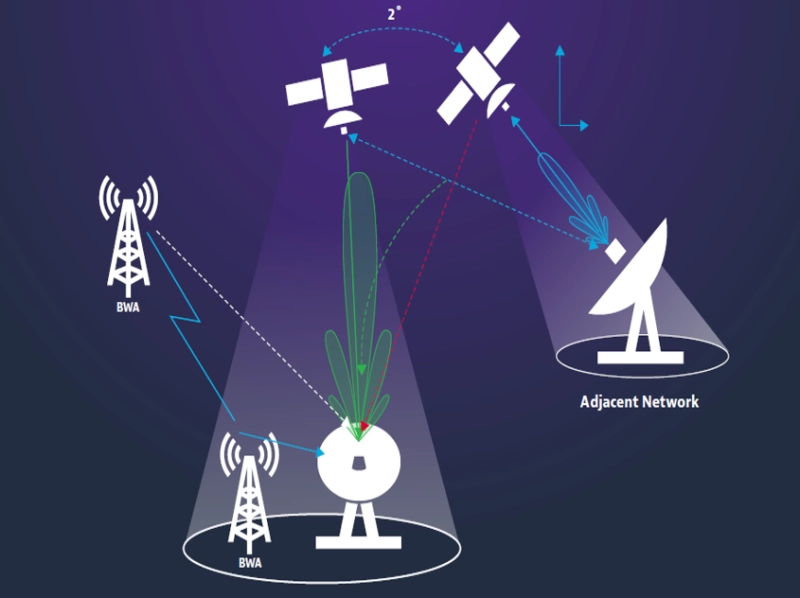What is C-band (Mid-band)?
Learn all about C-band, how to deploy it throughout the network lifecycle, as well as what spectrum clearance, timing & synchronization, and signal analysis are. Also get introduced to advanced test process automation for optimizing antenna alignment, fiber certification, coax verification, and coverage mapping.
Industry regulators continue to avail significant portions of C-band spectrum to wireless providers. 280MHz of spectrum was made available in the U.S. through an FCC C-band auction held in 2020. Operators paid over $80 billion in total to fortify 5G service in over 100 Partial Economic Area (PEA) markets. Satellite operators have now been tasked with relocating to a frequency range just above 4GHz.
The communications or “C” band of the radio spectrum was originally designated by the IEEE for satellite communications, terrestrial microwave radio, and other industrial applications. C-band frequencies repurposed for 5G wireless range from 3.7 – 3.98 GHz. C-band provides an outstanding balance between bandwidth and coverage, with the throughput needed to enable 5G use cases like enhanced mobile broadband (eMBB).
The terms C-band and “Mid-band” are often used interchangeably. It is more accurate to describe the C-band frequency range as a component of the larger 3.3 - 4.2 GHz mid-band spectrum. Mid-band resides within frequency range 1 (FR1), located squarely between low-band FR1 and the “millimeter wave” (FR2) RF spectrum. The term “C-band” is commonly referred to throughout North America, whereas “Mid-band” is more common in other parts of the world.
3GPP release 15 defines three distinct bands in this range: n77, n78, and n79, for mid-band 5G operation with potential channel bandwidth up to 100 MHz. In addition to offering gigabit throughput over the air, the range of mid-band is also sufficient to minimize cell tower installations.
-
Low-band spectrum provides outstanding coverage and can easily penetrate buildings or other common obstacles. This made low-band FR1 popular for 2G and 3G wireless deployments. Wider coverage translated to fewer cell towers and antennas, with their associated costs. Prior to LTE, the throughput offered by low-band wireless was adequate for most services.
-
Millimeter Wave (mmWave) is often associated with 5G technologies like beamforming and Massive MIMO. The shorter wavelength and high bandwidth of mmWave are ideally suited for 5G antenna arrays and use cases. However, frequencies above 24 GHz are also susceptible to obstacles, weather, and shadowing.
With coverage limited to 10s of meters, a 5G foundation built entirely on mmWave is not a realistic one. C-band allocation helps to smooth the transition by coupling large swaths of available spectrum with the superior coverage of C-band wavelength.
- Citizens Band Radio Service (CBRS) is also a component of the mid-band spectrum, although not a part of the C-band range. With approximately 150 MHz of spectrum located between 3.5 and 3.7 GHz, CBRS shares some positive traits with C-band frequencies. Historically used for satellite stations and military radar, CBRS mid-band spectrum was also actioned by the FCC in 2020, prior to the C-band auction. Although CBRS is already being utilized for TDD LTE, its usefulness for 5G will be limited by a “shared licensing” approach.
Given the optimal balance between coverage and bandwidth, C-band is sometimes referred to as the “waterfront property” of RF spectrum. This potential has been harnessed by past, present, and future occupants of the C-band frequency range.
- Satellite Operators have long recognized the value of C-band for over-the-air television transmission. The monolithic C-band dish of the 1980s has gradually been replaced by more compact dish formats, Wi-Fi, and fiber-based TV delivery. The FCC has incentivized these satellite operators to relocate their services above 4 GHz. Strict timelines have been set to clear the way for 5G services. Despite these assurances, C-band spectrum clearance is essential for ensuring minimal interference and optimal 5G network performance.
- Satellite Earth Stations, also known as ground stations, are additional occupants of the C-band spectrum used to stream and collect remote sensing satellite data. The power generated by Massive MIMO and beamforming can potentially saturate the C-band LNB (low noise block) downconverter of a C-band satellite antenna system. Spectrum clearance for 5G is essential near these stations to prevent 5G C-band antenna interference with satellite receive bands.
Interference in the C-band should be evaluated during planning and pre-deployment phases and as a best practice throughout commissioning, optimization, and maintenance phases. An RF spectrum analyzer used in conjunction with a directional antenna can detect the presence and source of unwanted signals that must cleared. The VIAVI OneAdvisor 800 spectrum analyzer with InterferenceAdvisor forms a fully automated tool kit for interference detection with pinpoint location.
Mid-band 5G wireless will unleash the full potential of the C-band radiofrequency spectrum. Faster speeds, higher capacity, and optimal coverage meet the need for a true 5G experience.
- 5G Use Cases
With channel bandwidth driving throughput, the primary use cases for 5G can be achieved in the C-band spectrum. This includes eMBB, ultra-reliable low-latency communications (URLLC), and massive machine type communications (mMTC) with high connection density. The millimeter wave can also accommodate these advanced applications. Coverage limitations make a hybrid approach including both mmWave and C-band more practical.
Dive deeper with the application note: The Role of C-band in 5G.
- Time Division Duplex (TDD)
All 5G deployments above 3 GHz, including 5G C-band, will utilize time division duplex (TDD) transmission rather than frequency division duplex (FDD). TDD gains spectral efficiency by allocating precise time slots for uplink and downlink signals over the same frequency. Persistence spectrum analysis is a useful technology for identifying interference during the transition between TDD uplink and downlink segments.
Timing and Synchronization are extremely important for TDD deployed over C-band. Timing requirements for TDD systems are necessarily strict to prevent crosstalk. Base stations are closely synchronized to a common phase clock reference. Frame and slot formats between adjacent networks must also be synchronized to prevent inter-cell interference.
- Beamforming
Beamforming and Massive MIMO enable 5G services to shift from a traditionally static, cell-centric model to a more dynamic, user-based approach. Beamforming is used to modify the phase and amplitude of multiple beams to direct energy more precisely into a user’s service area. Smaller mmWave and 5G C-band wavelengths enable beamforming by integrating a smaller form factor into larger arrays.




